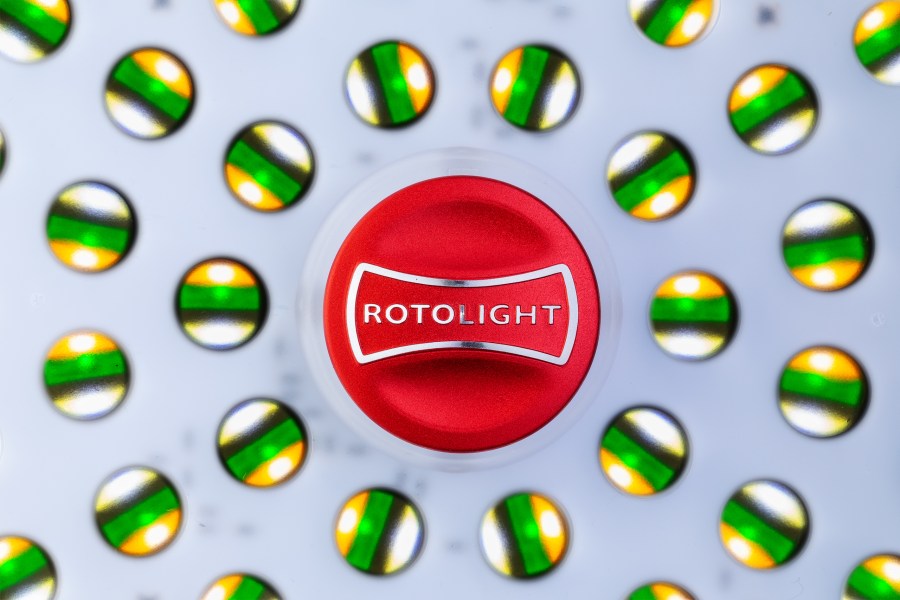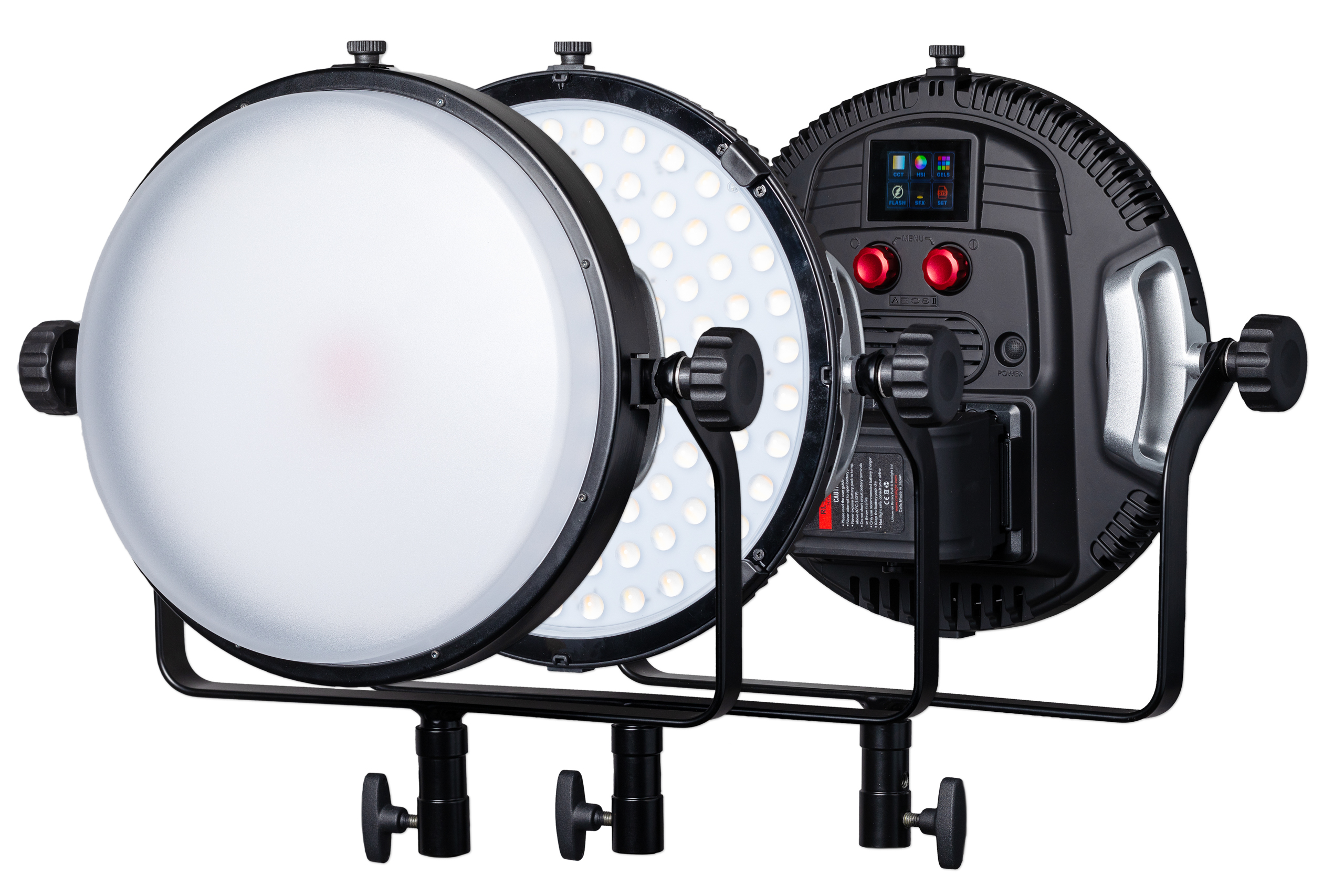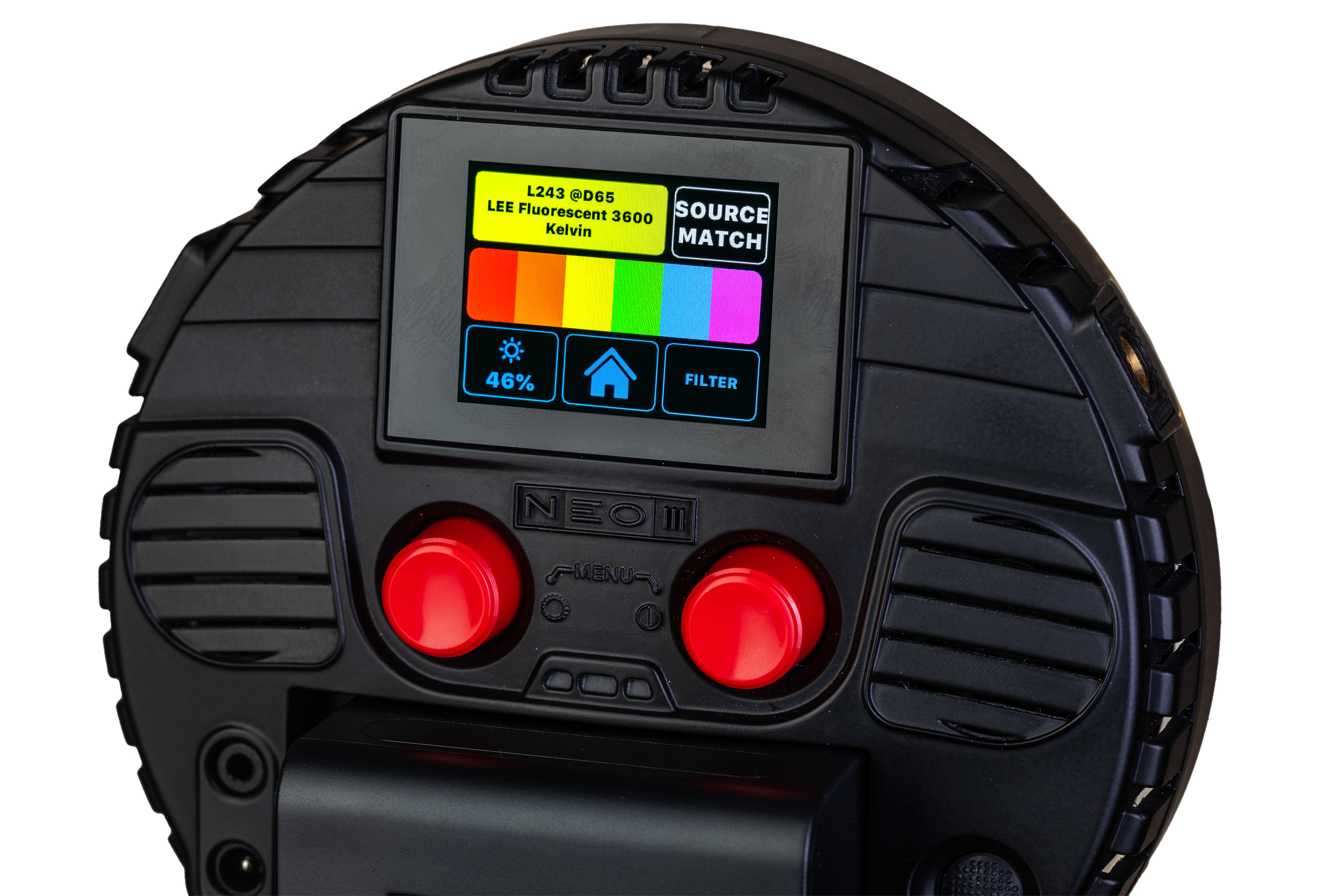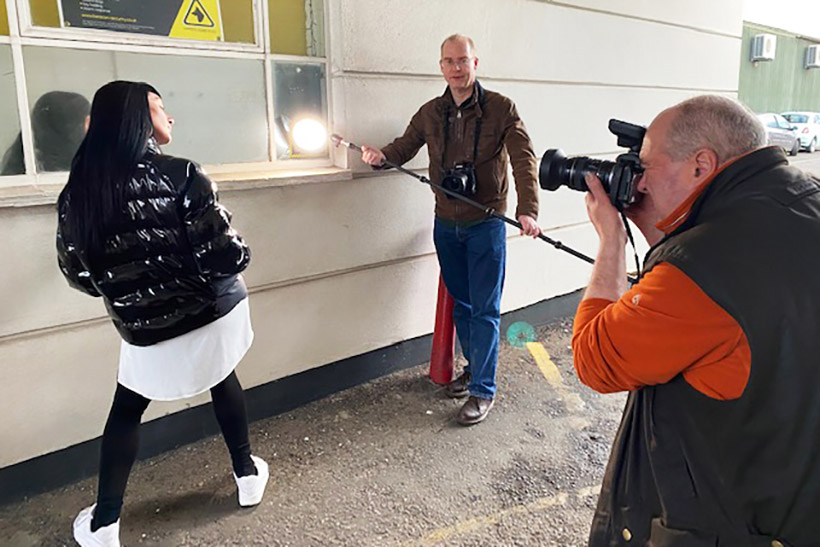Over the last ten years there have been major leaps in LED lighting development. In the UK, Pinewood Studios-based Rotolight has been at the forefront of this technology, and has created LED lights suited to both video and stills photographers in compact and lightweight units.
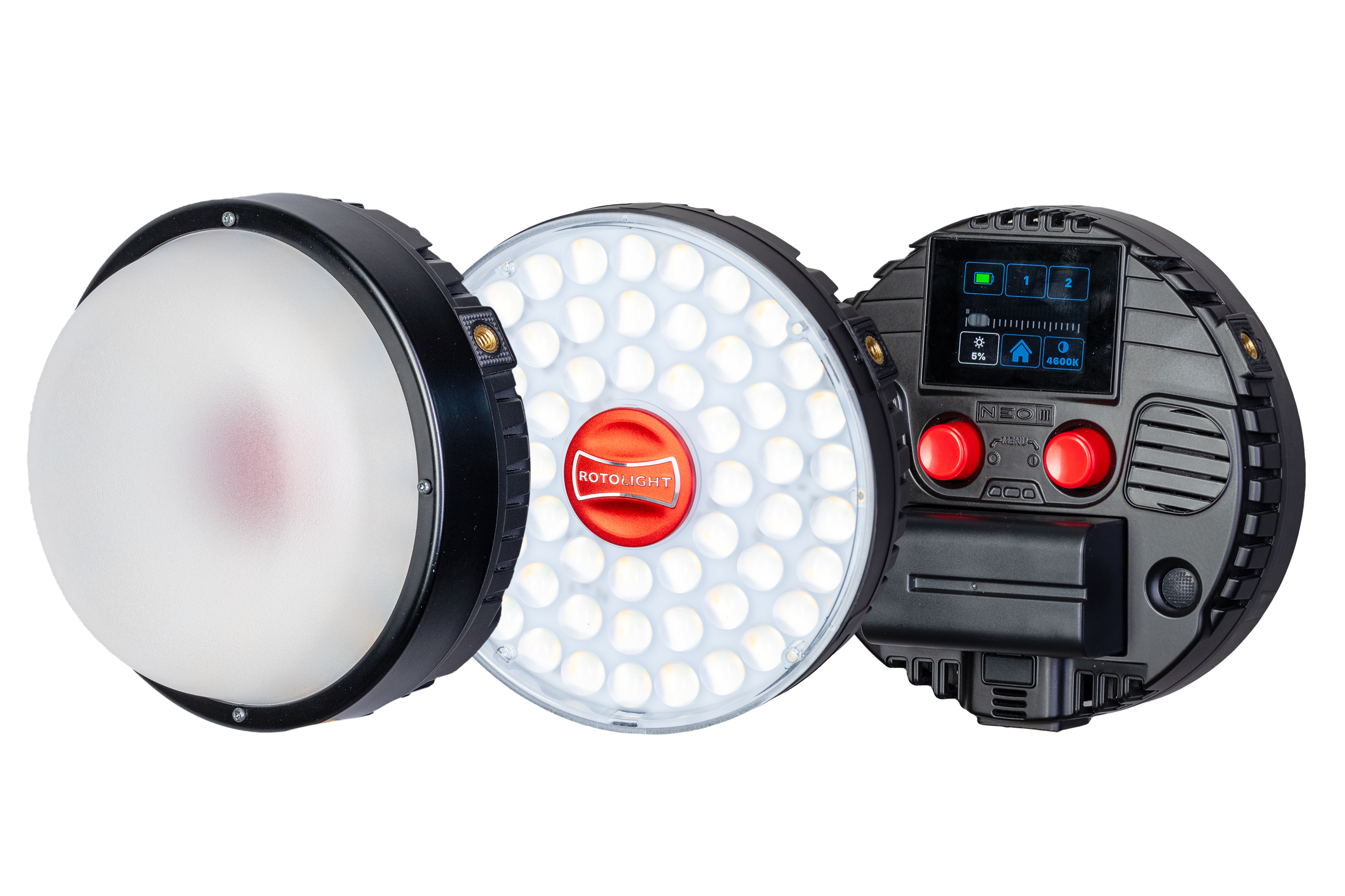
Rotolight Neo 3 with dome in place, showing LEDs and rear panel with touchscreen and NP series battery in place
Its latest models, the Rotolight NEO 3 and AEOS 2, are the first LED luminaires to use full-colour RGBWW technology to create lights which include accurate replication of lighting gels, along with full colour output for both flash and continuous light. Along with the ‘warm’ and ‘cool’ whites used in previous-generation bicolour LED lights, each LED ‘bead’ now incorporates red, green and blue stripes, which allows practically any colour to be reproduced. So there’s no longer any need to carry sheets or rolls of lighting gel with these portable, easy-to-use, battery-powered units.
Both the NEO 3 and AEOS 2 share the same core technology and controls, with the main difference between them being size and price. The NEO 3 is the smaller of the two, at 14.5cm in diameter, which makes it suitable for use as an on-camera light. Meanwhile, the AEOS is twice the diameter, and designed to be used on a lighting stand. On their own, the lights cost £514 and £1300, respectively.
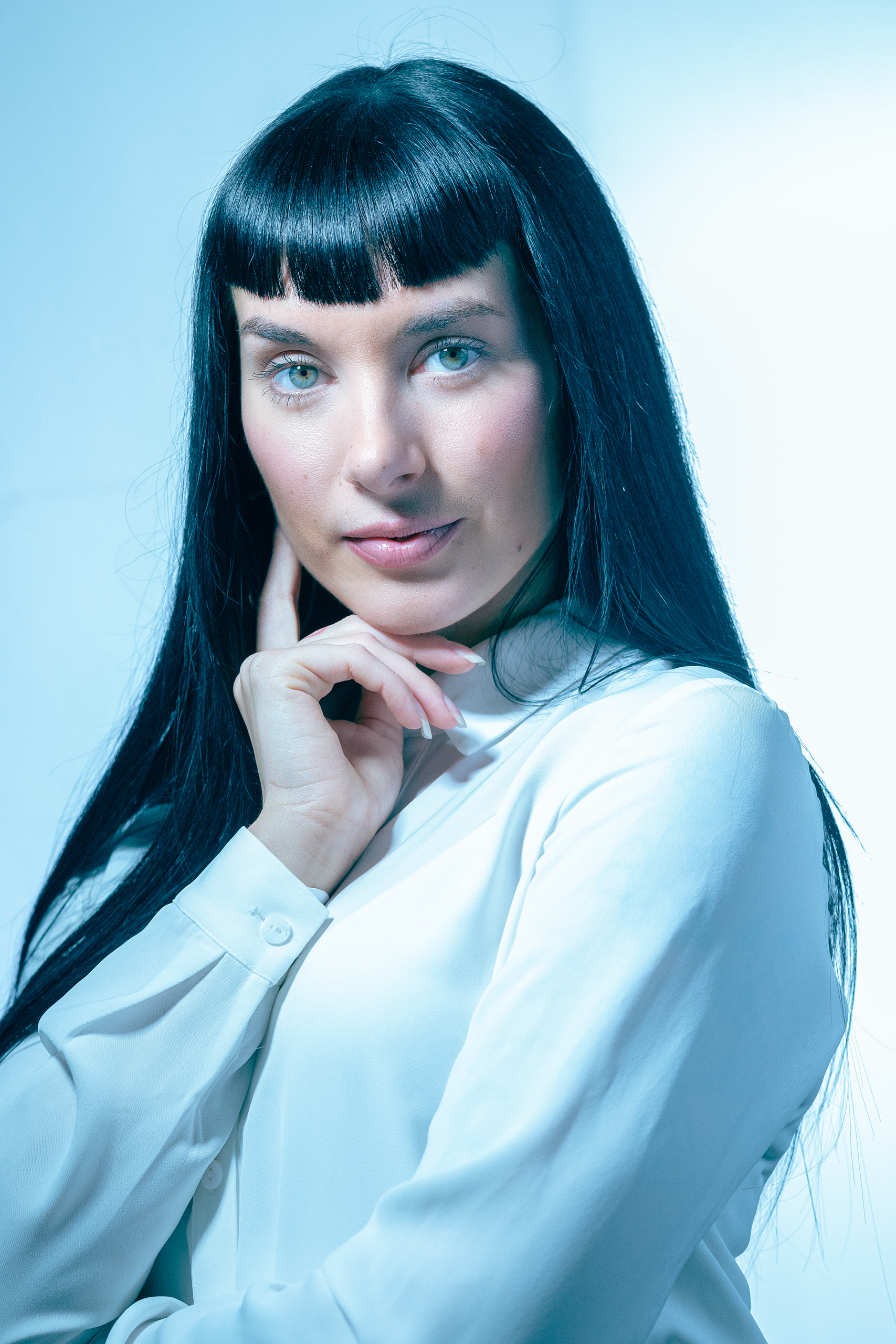
Studio high-key lighting with the NEO 3 as the key light, and the AEOS 2 to light the background. Continuous light with Simone posed against a white wall. Both lights were fitted with white diffusion domes. Canon EOS R, Canon EF 85mm f/1.8 USM, 1/160sec at f/5.6, ISO 1250.
At a glance
- £514 NEO 3; £1300 AEOS 2
- RGBWW full-colour LED lights
- High speed flash up to 1/8000 second
- Lightweight and portable
- Intuitive and responsive touchscreen control
- 16.7 million colours
- 2500 digital gel filters
- iOS and Android app
Background
Four years ago, Rotolight introduced the NEO 2 and AEOS luminaires to the photography and video film-making markets. At the time, they were unique due the fact that both flash and continuous light were possible from just one light. However, the NEO 2 and AEOS were somewhat slow and clunky to use, with simple seven-segment LED status displays – I carry laminated “How to” cards with my NEO 2. Controls were basic too, with just brightness and colour temperature adjustment available from 3150K to 6300K. Peak power output was delivered at 4200K, with all the bi-colour LEDs operating at full brightness, and limited video lighting effects were available.
Whilst being similar in size and appearance to the previous models, the new NEO 3 and AEOS 2 are now very different hybrid portable battery lights. Quite aside from their full-colour output, both have a new control system based on a rear touchscreen LCD. They also include built-in Bluetooth and Wi-Fi for control from a smartphone. Unlike the NEO 2, the NEO 3 is powered by a Li-ion rechargeable battery, rather than AAs, and it’s now fan-cooled too.

Outdoors I dialled in ¼ CTO lighting gel, L206. No clamps, no gaffer tape! Flash light triggered with an Elinchrom/Rotolight HSS transmitter. Aperture priority TTL exposure, exposure compensation -1.67 stops. Canon EOS R, Canon EF 85mm f/1.8 USM, 1/4000 sec at f/2.2, ISO 1250
Features and controls
Both the NEO 3 and AEOS 2 share many of the same common features. They promise bright output, 16.7 million colours with 2500 lighting filters, video lights effects, RGBWW flash, touchscreen display, and a native iOS and Android remote control app. Both offer a CCT Correlated Colour Temperature range of 3000K to 10,000K, covering the majority of artificial light sources and daylight.
Whilst not the least expensive RGBWW LED lights on the market, the NEO 3 and AEOS 2 have something that most other LED lights do not, and that’s a flash mode. In practice, the flash provides roughly twice the output of the continuous light. There is no recycle time, so the flash will keep up with the rapid continuous shooting speeds of even the fastest DSLR and mirrorless cameras.
Whilst the power output is not as high as conventional strobe-based flash units, the image sensors in modern DSLR and mirrorless cameras handle higher ISO settings with little grain or noise. For much of my work with my Canon EOS R full-frame mirrorless camera, with strobe-based flash I normally use ISO 160. But with the NEO 3 and AEOS 2 I use ISO 1250 most of the time, a difference of 3 stops.
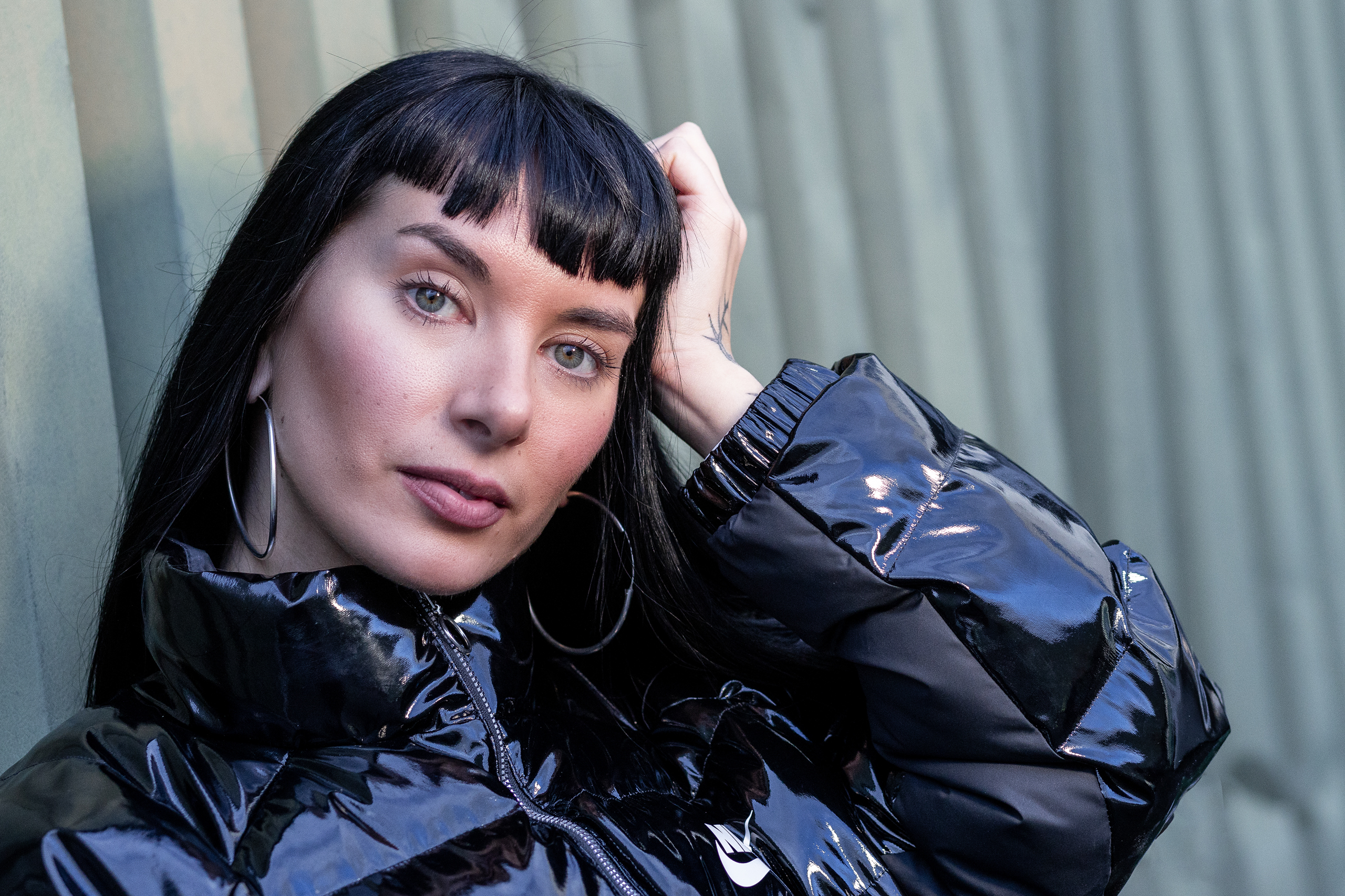
With care it’s possible to use the NEO 3 and AEOS 2 outdoors as a key light. The flash is set to manual, with maximum output at 1/50th second. This image was shot with the camera in Aperture Priority TTL auto exposure, with the ambient light influence reduced using -1.7 stops of exposure compensation. Canon EOS R, Canon EF 85mm f/1.8 USM, 1/500sec at f/4, ISO 1250.
NEO 3 and AEOS 2 kits and pricing
Each light has a range of accessories and is available in various kits. While the Rotolight NEO 3 costs £514.99 on its own, the £550 Ultimate Bundle represents the best value. It includes a dome diffuser, hot shoe adaptor, USB-C charger and cable, and a carry pouch with a belt loop. With the Rotolight charger, the NP-F battery will charge faster than with a standard NP-Series charger. A NEO 3 Three Light Kit is also available for £2,059. As its name suggests, it includes three lights with diffusion domes and light stands, all in a hard rolling case.
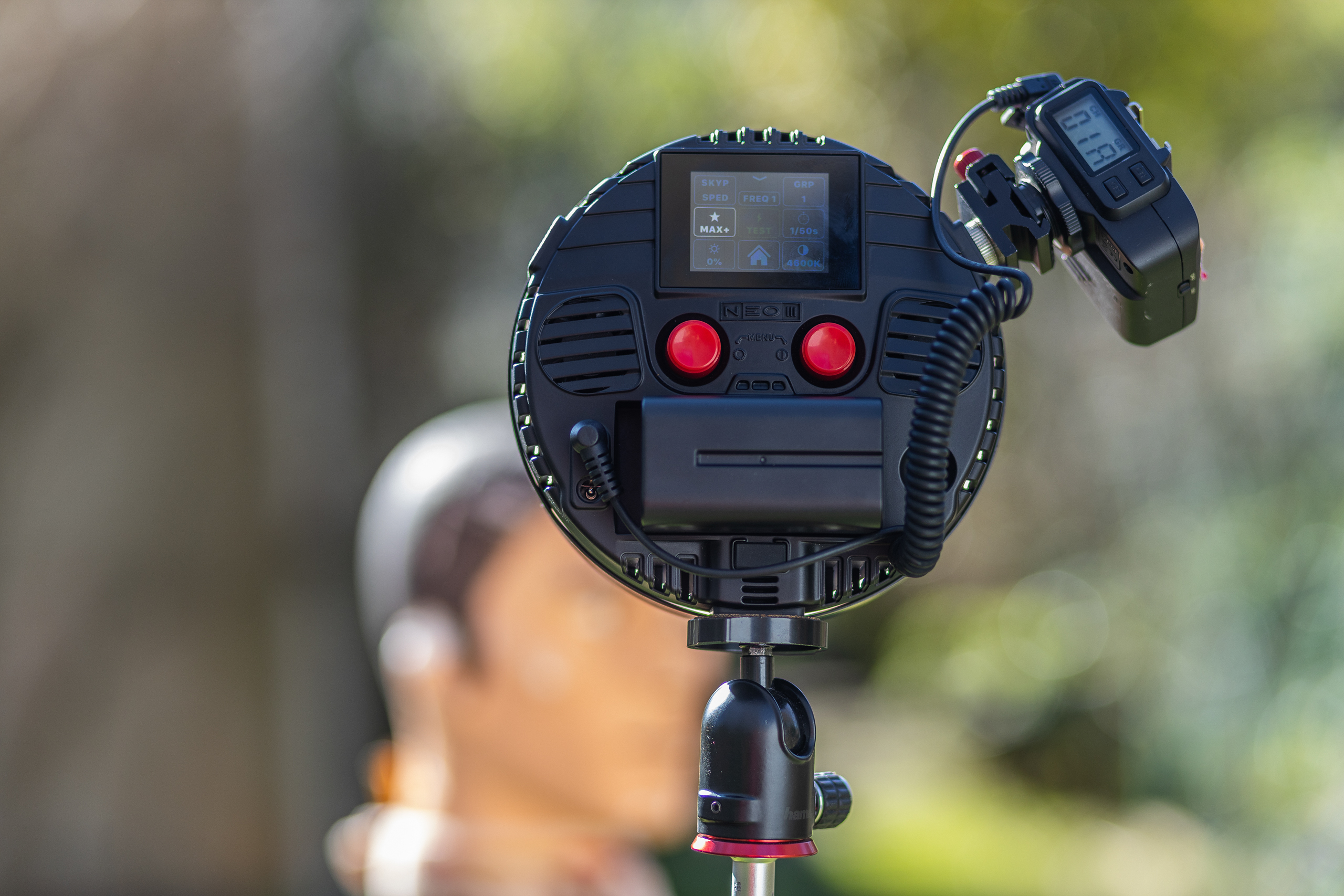
Rotolight Neo 3 outdoors in bright sunlight providing HSS key light, triggered with Pixapro ST-III TTL Rb (C) HSS flash receiver
The AEOS 2 Explorer kit includes a dome diffuser, v-lock 95Wh battery, charger, mains power supply and carry case, for £1,549. There’s also an AEOS 2 Ultimate kit that includes two lights with diffuser domes, stands, 95Wh batteries and a charger, along with a soft bag, power supply units and cables, all for £2,915. Meanwhile the AEOS 2 Masters kit (£2,400) is similar to the Ultimate kit but without any v-lock batteries, just mains power supplies. This makes it ideal for indoor and studio use, where AC mains is always available.
Remote control app
There will be a Rotolight app to control the lights from either iOS or Android devices, using their built-in Bluetooth and Wi-Fi connectivity. The app will allow you to switch between lighting modes; adjust colour, power, or flash; and select gels and lighting effects, all remotely. You will also be able to create custom groups with up to 20 lights simultaneously. Unfortunately, the app was unavailable at the time of writing, so I was unable to test it for this review.
Operating modes
Both the AEOS 2 and the NEO 3 provide a wide range of operating modes, which makes them among the most versatile lights on the market. Using the touchscreen control, you can select between colour temperature, HSI colour, gel colours, and special effects (SFX).
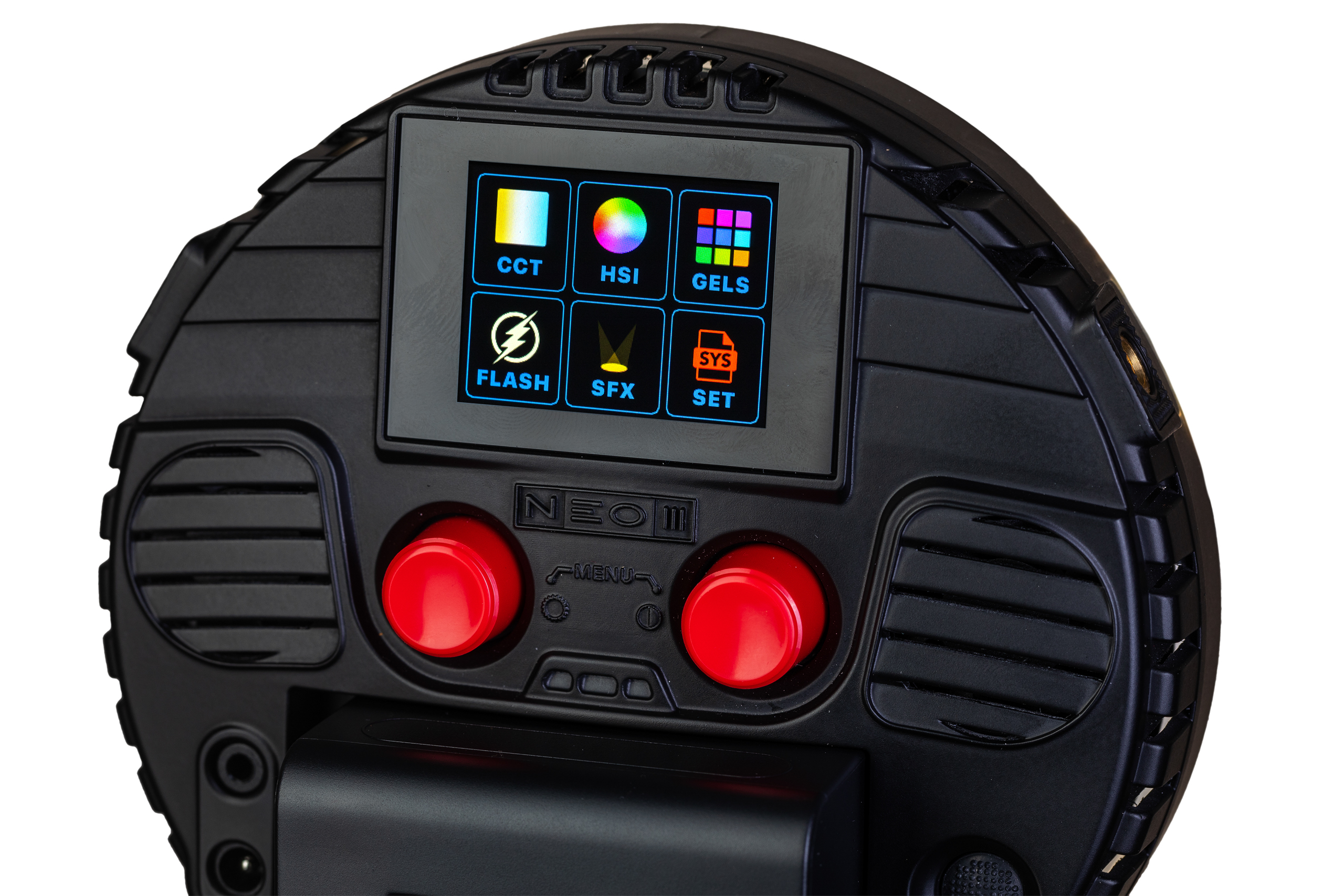
Rotolight Neo 3 menu screen. On startup, once the splash screen disappears the menu appears giving easy access to CCI Correlated Colour Temperature; HSI Hue, Saturation, Intensity; digital gel filters; flash, video FX and set-up.
Correlated Colour Temperature (CCT)
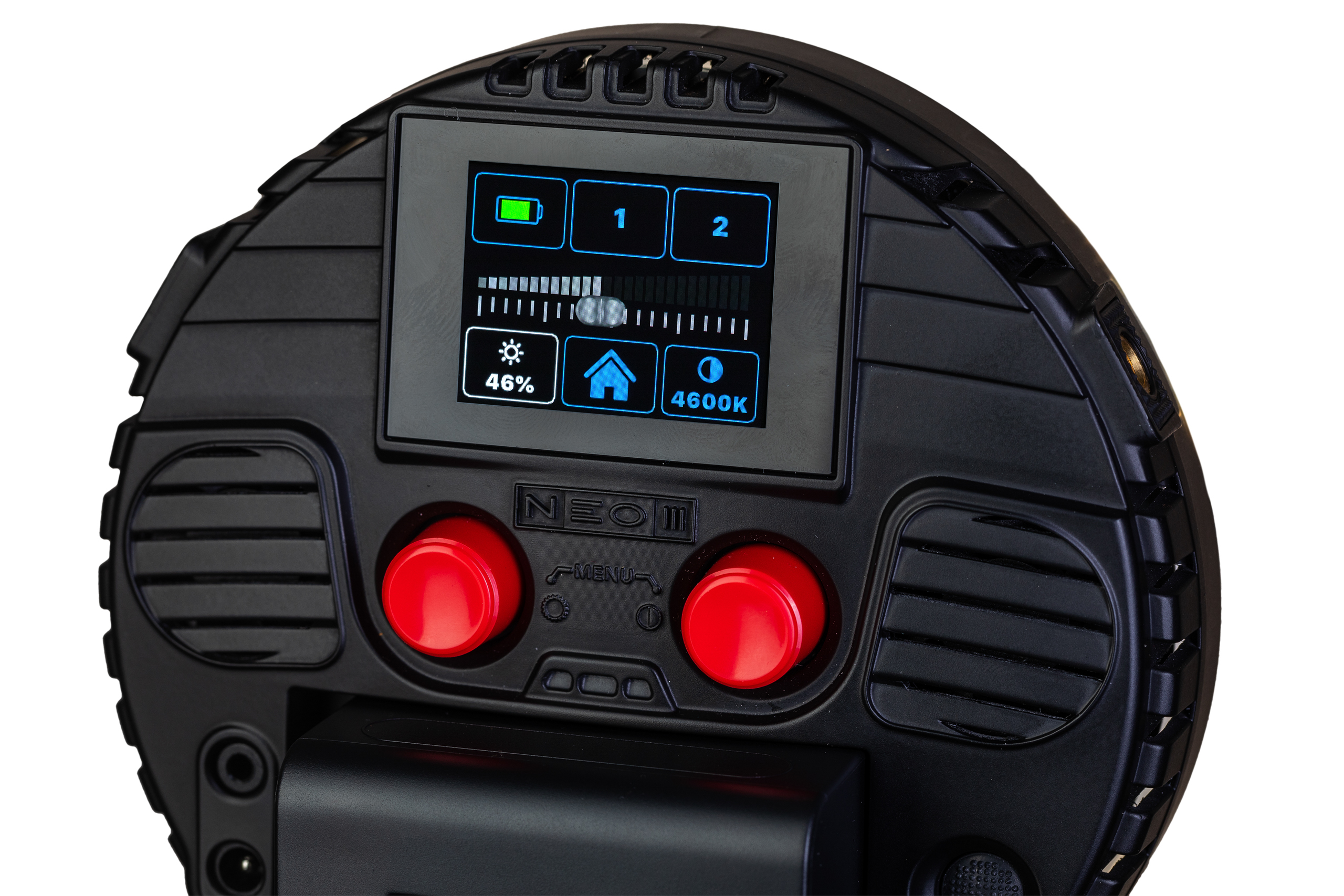
Rotolight Neo 3 brightness screen. Here you adjust the brightness and colour temperature. There are two presets to aid workflow.
This allows you to adjust the colour temperature from 3000K – 10,000K in 20K steps. It allows you to match the colour temperature of the Rotolights to the ambient lighting, from the warm orange of hot lights to the cooler hues of bright sunlight. This is the mode most photographers are likely to use most often. Maximum output with both the NEO 3 and AEOS 2 is around 4600K, but this is not a Kelvin colour temperature that’s often used. Instead, many photographers will prefer daylight (around 5300K) where maximum output is reduced.
Hue, Saturation, Intensity (HSI)
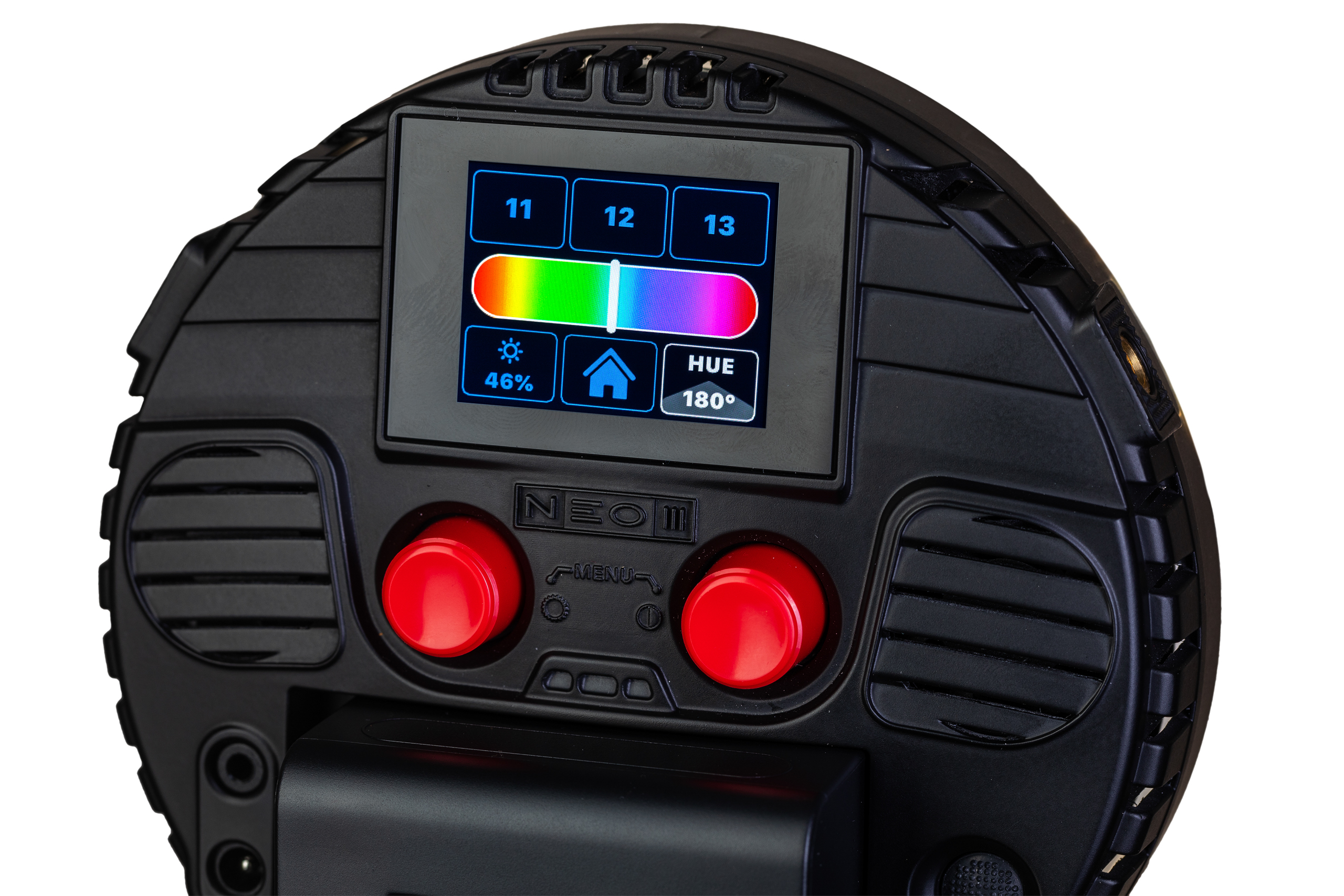
Rotolight Neo 3 HSI Hue, Saturation, Intensity screen allows 16.7 million colours to created, including colour sampling from images within the app.
In this mode, the lights provide independent adjustment for hue, saturation and intensity, giving a choice of 16.7 million colours. It should be noted that once you begin dialling in HSI colours or gels, the light output will be reduced compared the maximum possible in CCT mode.
Gels
Rotolight has programmed the spectral characterises for up to 2500 digital filters including the daylight and tungsten emulation. For now, you can only scroll through the selections using the touchscreen on the lights. Hopefully, once the app is released, you’ll be able to select between the many available gels with much greater ease.
Special Effects (SFX)
Award winning lighting effects to enhance music videos, short films or even features, designed by Stefan Lange (Skyfall, Tomb Raider, Batman). The SFX can be triggered with the right-side button, via the app, or using the test button on the Elinchrom Skyport trigger. There are 12 effects to choose from: fade, lighting, strobe, cycle, fire, police, TV, gunshot, neon, film, weld and paparazzi.
Flash
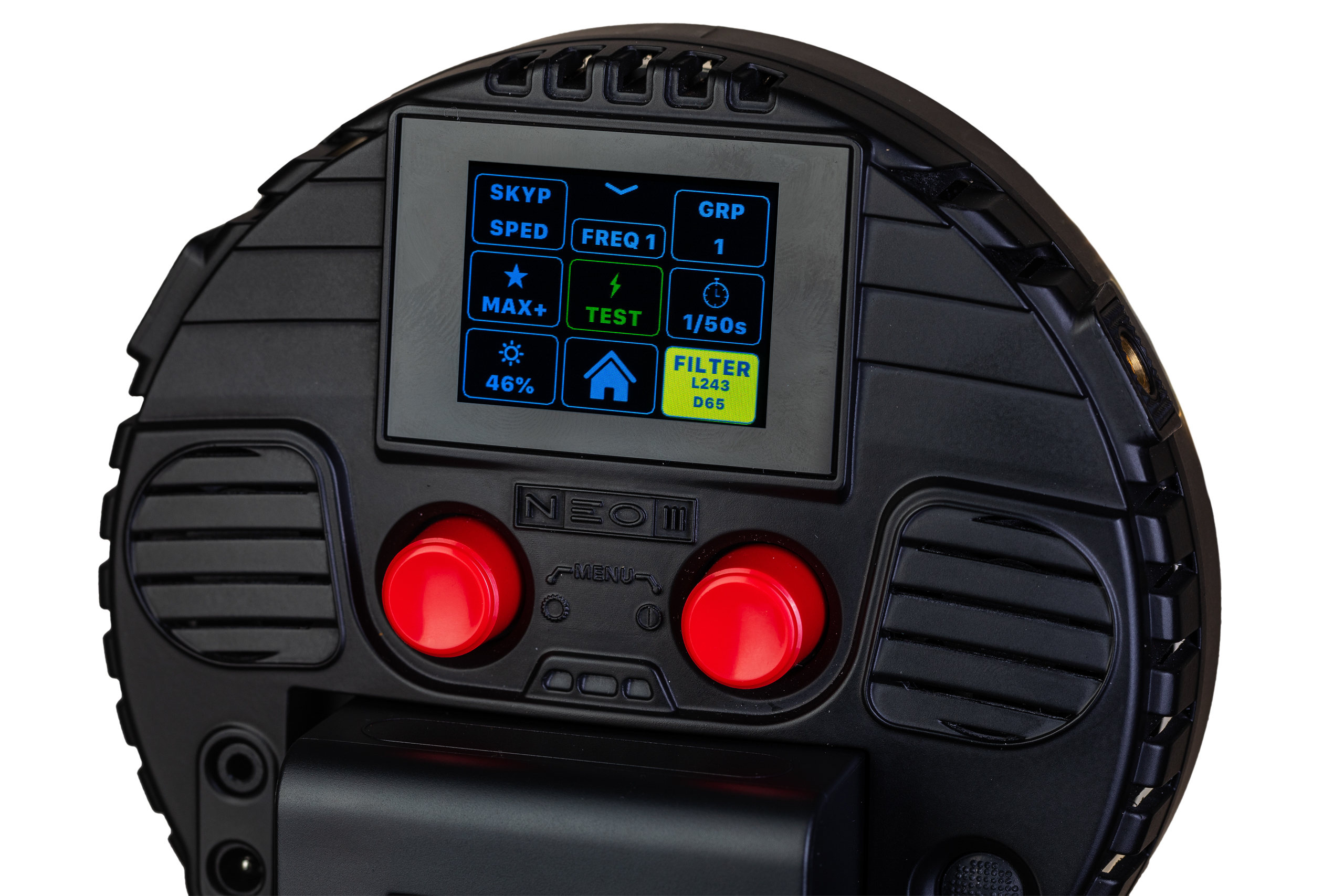
Rotolight Neo 3 flash screen. The flash screen allows you to adjust the LED brightness which is effectively a modelling light for the flash. Flash power is controlled by flash duration. Full flash power is 1/50th second. With the Elinchrom Skyport trigger it’s possibles to set lighting groups and channels for working with multiple set-ups or photographers.
The big advantage of the NEO 3 and AEOS 2 over conventional flashes is the ability to flash in CCT, Gel and HSI modes. You can use any of the 16.7 million colours, or any of the 2500 digital gel filters, at shutter speeds up to 1/8000 second. Both the NEO 3 and AEOS 2 have built-in Elinchrom Skyport receivers. Alternatively, an external HSS flash receiver can be plugged into the HSS socket, but this will lose the ability to set the power remotely. Unlike traditional flashes, LED flash does not suffer with recharge time between shots. Whilst neither the NEO 3 or AEOS 2 possess the flash power of a Speedlite, with care they can be used effectively outdoors, either in shade or when there’s overcast sky.
Rotolight NEO 3
For its size and weight, the NEO 3 is a very capable light. It’s a battery powered on- or off-camera flash and video light, housed in a small unit. This makes it ideal for hybrid photographers who shoot stills and moving images on the move. It’s light enough to be used on your camera’s hot shoe without the diffusion dome, or off-camera on a light stand with the diffusion dome. There is no need to carry lighting gels as they can be selected from the touchscreen menu. Along with an in-built Elinchrom Skyport receiver, there’s a socket for an external flash receiver, allowing use as a wireless off-camera flash. There’s also a socket for an external 24V DC supply.
Personally, I’d use the NEO 3 more off-camera than on my camera hot shoe, either on a side bracket or free-standing light stand. To this end, the NEO 3 has three standard ¼ inch 20 TPI UNC threads for mounting to ball heads or light stands, or fpr attaching an external flash receiver. Used as a flash it lacks the power of a Speedlite or hot shoe flash, which means some photographers will need to modify their technique and embrace shooting at higher ISO settings. But in return, the LED flash is fast enough to keep pace with the very latest mirrorless cameras, as there is no recycle time. This means 30 frames per second flash is now a reality.
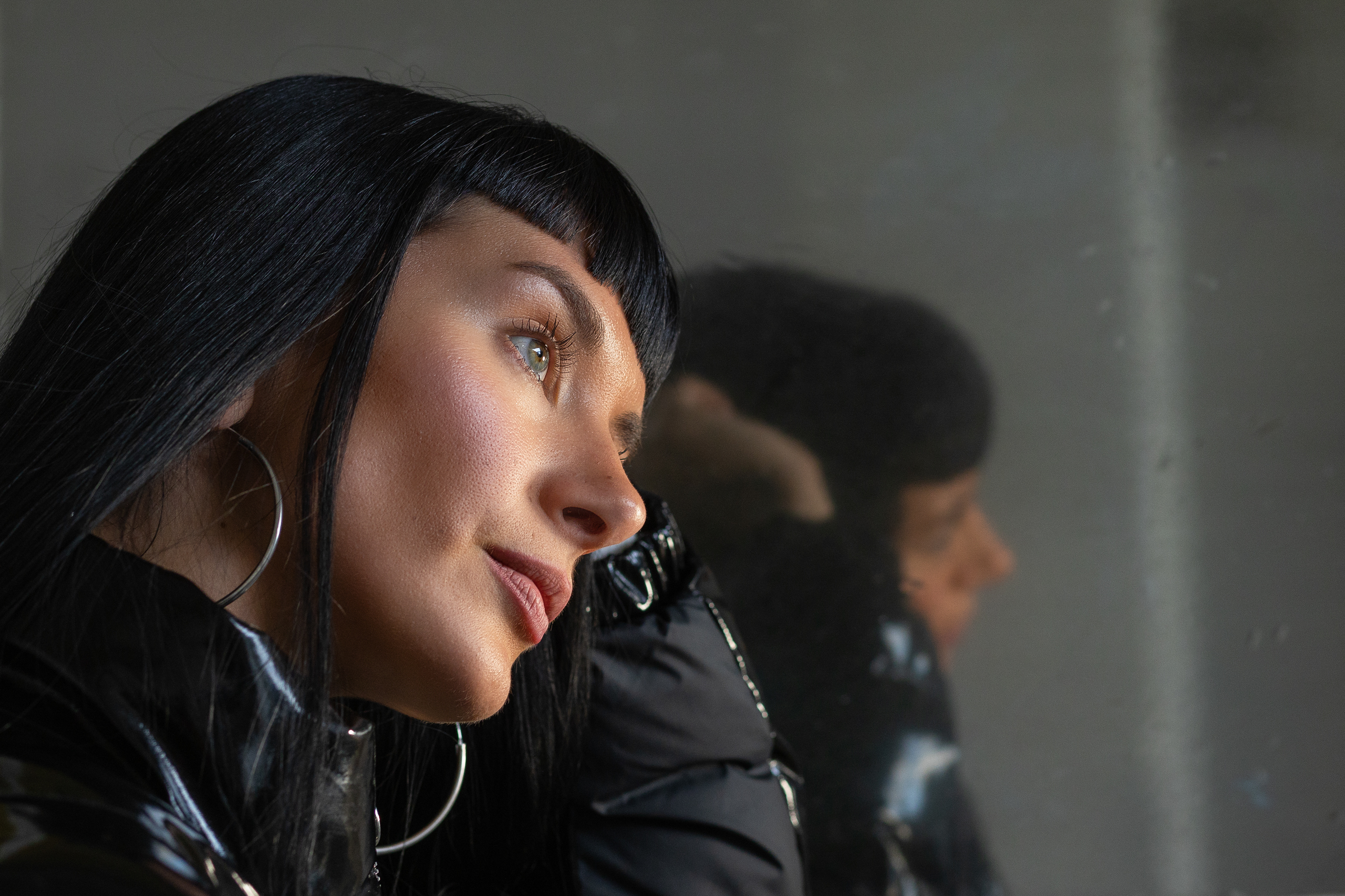
Top shade provided controlled ambient light to create beautiful soft flash light from the NEO 3 with dome diffuser in place. Canon EOS R, Canon EF 85mm f/1.8 USM, 1/125 sec at f/5, ISO 1250, daylight white balance. NEO 3 at 4600K, the point where all the LEDs reach maximum output.
In controlled tests I metered the NEO 3’s continuous output at ƒ/4, 1 meter, ISO 100. Its flash output metered at ƒ/4.8, with the diffusion dome in place. In context, an undiffused 60Ws Speedlite metered ƒ/22 under the same test conditions. This means you often need to increase the camera’s ISO and/or get the light close to the subject. This is where the dome diffuser becomes invaluable, as it helps give softer light with more diffused shadow transitions.
Unlike the older NEO 2, the NEO 3 will not run on AA batteries, as the power draw has increased considerably from 12W to 50W. Instead, the NEO 3 is now supplied with a Sony L-Series NP-F battery. Alternatively, it can be powered by a supplied 24V adaptor. The DC input also allows use of alternative power sources, such as a V-lock battery (as used by the AEOS 2) via its D-Tap port. You could even use a portable mains supply such as a generator or DC-AC invertor when working outdoors.
As power use increases, so does heat generated by the lights. This is no different with either the NEO 3 or AEOS 2. When using the units indoors at 4600K and 100% power, where they provide their highest light output, the fans kick in after only a few minutes and are quite audible. I have read reports of the fan being too noisy for recording sound with video, however my test of the fan noise read 40 dB, which falls within standards for audio recording. But I would recommend conducting your own tests if you decide to use either of these lights for sync sound video recording.

Rotolight NEO 3 Specifications
- Maximum output 3ft 5,443 Lux continuous
- 10,700 Lux flash
- TLCI/CRI 99/95
- Power consumption 50W
- Power supply Battery NPF-750
- 24V DC
- Mounting ¼ inch 20 TPI or cold shoe
- Size 145 mm wide x 50 mm deep
- Wireless control Wi-Fi & Bluetooth (iOS/Android app)
- Elinchrom Skyport Pro (built-in)
- Socket for third-party receiver
- Maximum flash shutter speed 1/8000 second
- Beam angle 50 degrees
Rotolight AEOS 2
With a diameter of about 30cm, the AEOS 2 has approximately four times the surface area of the NEO 3. Yet it only weighs 2.3 kg without the high-capacity V-lock battery in place; add the battery and the combination weighs 3 kg. It’s fitted with a yoke which has a standard ⅝ inch female receptor mount, allowing direct fixing to light stands and the majority of standard lighting grip gear. There are handles for off-stand use and the unit is well balanced when used this way, as the battery is placed low on the back of the light.
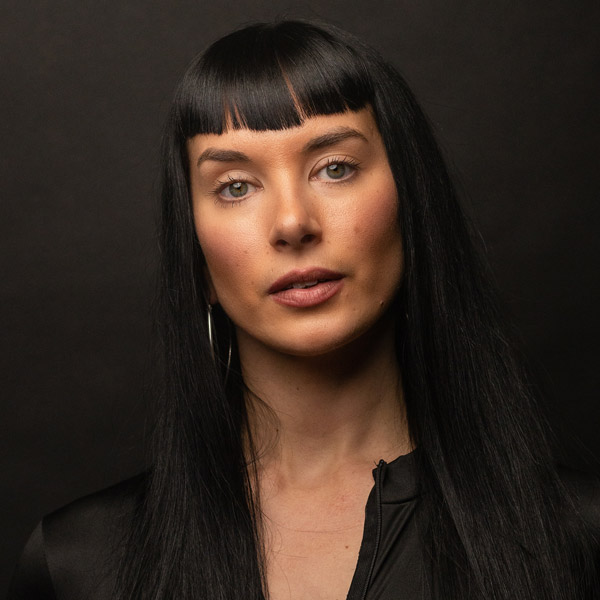
Continuous light in the studio. Paramount-style lighting with the AEOS 2, dome diffuser and white shoot-through umbrella just out of frame, high 45º camera left. The NEO 3 provided the warm hair light, with 02 Amber gel dialed in. Canon EOS R, Canon EF 85mm f/1.8 USM, 1/160sec at f/5.6, ISO 1250, white balance 5300K
The AEOS 2 provides sufficient power to use it outdoors as a video light and balance with the ambient light. It also shares the flash function as the NEO 3, which is approximately double the output of the continuous light. In controlled tests I metered the AEOS 2 at ƒ/5, 1 meter, ISO 100. Flash delivers ƒ/8 with the diffusion dome in place.
All the functions, and the intuitive and responsive touchscreen, are shared with the NEO 3. The touchscreen layout is sufficiently logical and well-designed that these lights can be used out of the box without even needing to read the Quick Start Guide. If you’re not in a position to use the touch screen, most obviously when wearing gloves, it’s possible to make adjustments using the two red buttons under the display.

Continuous light in the studio. With both the AEOS 2 and NEO 3, changing colours is quick and easy. Here, the AEOS 2 provided the blue accent light, and the NEO 3 the red key light. The black background was illuminated by an original AEOS, with a LEE Filters 738 Jas Green gel taped in place. Canon EOS R, Canon EF 85mm f/1.8 USM, 1/250sec at f/5.6, ISO 1250, daylight white balance.
As with many LED luminaires the AEOS 2 and NEO 3 are bulky compared to portable battery flashes, but no more than carrying both flash kit and continuous light sources at the same time. For readers who shoot stills and also want to shoot video, these lights will be a versatile all-in-one package, reducing the gear carried. It’s just worth bearing in mind that v-lock batteries for the AEOS 2 are bulky and heavy.

Rotolight AEOS 2 Specifications
- Maximum output 3ft 11,500 Lux continuous
- 17,500 Lux flash
- TLCI/CRI 99/95
- Power consumption 120W
- Power supply V-lock battery
- 24V DC 150W
- Mounting ¼ inch 20 TPI or optional yoke
- Size 295 mm wide x 25 mm deep
- Wireless control Wi-Fi & Bluetooth (iOS/Android app)
- Elinchrom Skyport Pro (built-in)
- Socket for third-party receiver
- Maximum flash shutter speed 1/8000 second
- Beam angle 50 degrees
Footnote – My thanks to Simone Jane Piper from MK Model management in Brighton, and Andy Westlake AP Technical Editor and Nigel Atherton, AP Editor for assistance on on the shoot.

